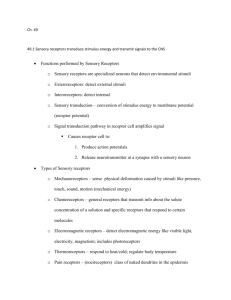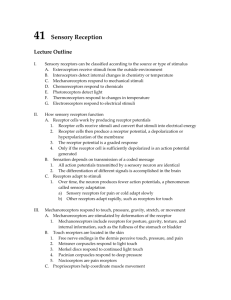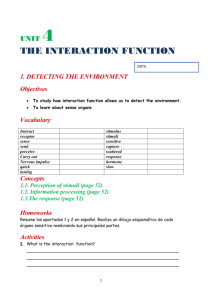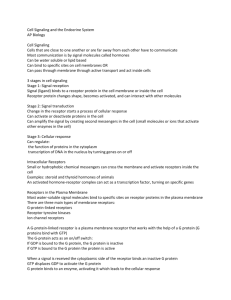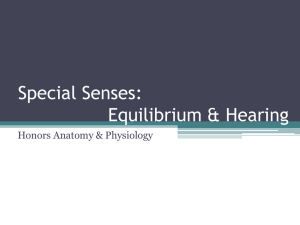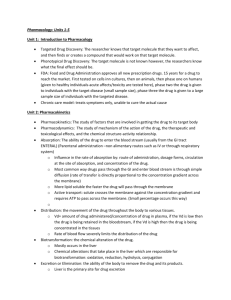CHAPTER SUMMARY
advertisement
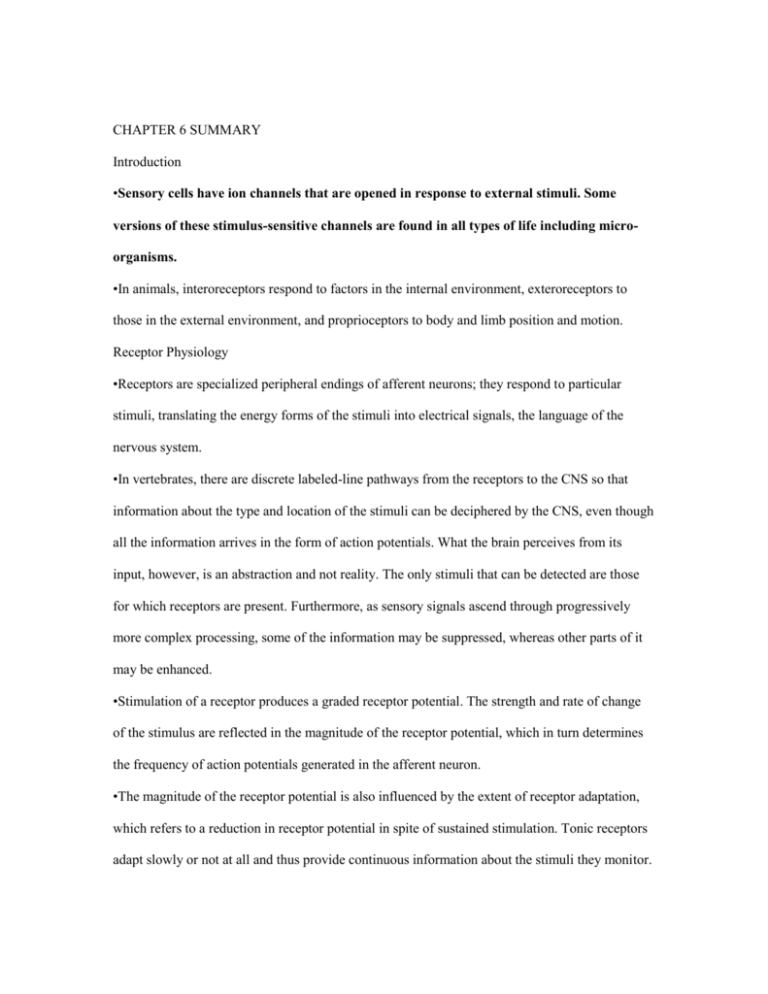
CHAPTER 6 SUMMARY Introduction •Sensory cells have ion channels that are opened in response to external stimuli. Some versions of these stimulus-sensitive channels are found in all types of life including microorganisms. •In animals, interoreceptors respond to factors in the internal environment, exteroreceptors to those in the external environment, and proprioceptors to body and limb position and motion. Receptor Physiology •Receptors are specialized peripheral endings of afferent neurons; they respond to particular stimuli, translating the energy forms of the stimuli into electrical signals, the language of the nervous system. •In vertebrates, there are discrete labeled-line pathways from the receptors to the CNS so that information about the type and location of the stimuli can be deciphered by the CNS, even though all the information arrives in the form of action potentials. What the brain perceives from its input, however, is an abstraction and not reality. The only stimuli that can be detected are those for which receptors are present. Furthermore, as sensory signals ascend through progressively more complex processing, some of the information may be suppressed, whereas other parts of it may be enhanced. •Stimulation of a receptor produces a graded receptor potential. The strength and rate of change of the stimulus are reflected in the magnitude of the receptor potential, which in turn determines the frequency of action potentials generated in the afferent neuron. •The magnitude of the receptor potential is also influenced by the extent of receptor adaptation, which refers to a reduction in receptor potential in spite of sustained stimulation. Tonic receptors adapt slowly or not at all and thus provide continuous information about the stimuli they monitor. Phasic receptors adapt rapidly and frequently exhibit off responses, thereby providing information about changes in the energy form they monitor. Photoreception: Eyes and Vision •The vertebrate eye is a camera-type eye, specialized structure housing the light-sensitive receptors essential for vision perception—namely, the rods and cones found in its retinal layer. The iris controls the size of the pupil, thereby adjusting the amount of light permitted to enter the eye. The cornea and lens are the primary refractive structures that bend the incoming light rays to focus the image on the retina. The cornea contributes most to the total refractive ability of the eye. •Rods and cones are activated when the photopigments they contain differentially absorb various wavelengths of light. Light absorption causes a biochemical change in the photopigment that is ultimately converted into a change in the rate of action potential propagation in the visual pathway leaving the retina. The visual message is transmitted to the visual cortex in the brain for perceptual processing. •Cones display high acuity but can be used only for day vision because of their low sensitivity to light. Different ratios of stimulation of the various cone types by varying wavelengths of light lead to color vision. •Rods provide only indistinct vision in shades of gray, but because they are very sensitive to light, they can be used for night vision. •Advanced camera-type eyes are also found in cephalopods; their structures show that they evolved independently of the vertebrate eye. •The functional unit of the arthropod faceted, or compound, eye is termed the ommatidium. Each ommatidium consists of an optical, light-gathering part as well as a sensory portion, which transduces light into an action potential. Mechanoreception: Touch and Pressure •Mechanically gated channels transduce touch and pressure into electrical signals. •Channel proteins have external protein fibers attached to them, and when these fibers are stretched or distorted, they essentially pull open the gate of the ion channel. •Cations entering the sensory dendrite create a receptor potential and, if the signal is strong enough, action potentials. Mechanoreception: Proprioceptor Organs •Numerous classes of animals have gravity receptors, known as statocysts, which are considered the simplest organs of equilibrium. A statocyst is essentially a hollow chamber lined with ciliated mechanoreceptors that contain dense, moveable objects, the statoliths. •This sense organ is particularly important in animals that are essentially neutrally buoyant such as fish, for they lack information about gravity from other sensory sources. •In fish, mechanoreceptor systems extend the length of the animal’s body. Information about the fish’s orientation with respect to gravity, its swimming velocity and details about water currents and vibrations are collected by a string of neuromast cells, the basic sensory unit of the lateral line system. Each neuromast is dome-shaped, with up to several hundred mechanoreceptor sensory hair cells clustered at its base. •Microvillar processes called stereocilia are the actual sensory transducers that protrude from the sensory hair cells into a jellylike substance (at the base of the dome). Stereocilia are arranged together into ciliary bundles and are orientated according to size. •Neuromasts continually send out bursts of nerve impulses: when pressure waves cause the gelatinous caps of the neuromasts to move, the enclosed hairs are bent. If the ciliary bundle is bent in the direction of the tallest row of stereocilia, this results in an excitatory depolarization of the hair cell whereas bending in the opposite direction generates an inhibitory hyperpolarization. The actual magnitude of the response depends on the degree of bending. Mechanoreception: Ears and Hearing •The mammalian ear performs two unrelated functions: (1) hearing, which involves the external ear, middle ear, and cochlea of the inner ear; and (2) sense of equilibrium, which involves the vestibular apparatus of the inner ear. •In contrast to the photoreceptors of the eye, the ear receptors located in the inner ear—the hair cells in the cochlea and vestibular apparatus—are mechanoreceptors. Hearing depends on the ear’s ability to convert airborne sound waves into mechanical deformations of receptive hair cells, thereby initiating neural signals. •Sound waves are funneled through the mammalian external ear canal to the tympanic membrane, which vibrates in synchrony with the waves. Middle ear bones bridging the gap between the tympanic membrane and the inner ear amplify the tympanic movements and transmit them to the oval window, whose movement sets up traveling waves in the cochlear fluid. These waves, which are at the same frequency as the original sound waves, set the basilar membrane in motion. Various regions of this membrane selectively vibrate more vigorously in response to different frequencies of sound. •On top of the basilar membrane are the receptive hair cells of the organ of Corti, whose hairs are bent as the basilar membrane is deflected up and down in relation to the overhanging stationary tectorial membrane in which the hairs are embedded. This mechanical deformation of specific hair cells in the region of maximal basilar membrane vibration is transduced into neural signals that are transmitted to the auditory cortex in the brain for sound perception. •The vestibular apparatus in the mammalian inner ear consists of (1) the semicircular canals, which detect rotational acceleration or deceleration in any direction, and (2) the utricle and saccule, which detect changes in the rate of linear movement in any direction and provide information important for determining head position in relation to gravity. Neural signals are generated in response to mechanical deformation of hair cells caused by specific movement of fluid and related structures within these sense organs. This information is important for the sense of equilibrium and for maintaining posture. Chemoreception: Taste and Smell •Taste and smell are chemical senses. In both cases, attachment of specific dissolved molecules to binding sites on the receptor membrane causes receptor potentials that, in turn, set up neural impulses that signal the presence of the chemical. •Taste receptors are housed in taste buds on the mammalian tongue; olfactory receptors are located in the mucosa in the upper part of the nasal cavity. Both sensory pathways include two routes: one to the limbic system for emotional and behavioral processing and one through the thalamus to the cortex for conscious perception and fine discrimination. Taste and olfactory receptors are continuously renewed, unlike visual and hearing receptors, which are irreplaceable. Thermoreception •Vertebrates have at least two kinds of thermoreceptors: cold sensors and warmth sensors. These inform the brain about skin and internal temperatures to aid in thermoregulation. •At least two groups of animals, the pit vipers, and some pythons and boas, have a third type, an extraordinarily sensitive receptor that responds to infrared radiation, the low-energy radiation that carries heat energy. The receptor cells are simply branched dendrites of neurons, located in small pits in the skin, on either side of the head in pit vipers (anterior to and below the eyes), and along the jaws of pythons. Nociception •Painful experiences are elicited by noxious mechanical, thermal, or chemical stimuli and consist of two components: the perception of pain coupled with behavioral responses to it. •Pain signals are transmitted over two afferent pathways in vertebrates: a fast pathway that carries sharp, prickling pain signals; and a slow pathway that carries dull, aching, persistent pain signals. •Descending pathways from the brain use endogenous opiates to suppress the release of substance P, the neurotransmitter from the afferent pain fiber terminal. This blocks further transmission of the pain signal and serves as a built-in analgesic system. Electroreception and Magnetoreception •Active electroreception (in some fishes) resembles echolocation in that the animal assesses its environment by actively emitting signals and receiving the feedback signal. An electric organ in the tail of the fish discharges a current field, which emanates from its anterior body and then converges on the tip of the tail. Passive electroreception, as in sharks, detects only fields produced by other animals (such as prey). Ampullary and tuberous electroreceptors on the anterior body surface in the lateral line system monitor changes in external current flow. •Several fish species, such as the electric eel, can produce discharges up to several hundred volts outside their bodies, whereas in the majority of species the discharge is limited in range to millivolts to volts. Strong voltages are emitted to stun or kill prey, while weak discharges are emitted continually for electrolocation and social communication. •The highly sensitive electroreceptors of elasmobranchs are also capable of detecting the earth’s magnetic field. Movement of the fish across magnetic field lines produces distortions in the electric currents, which are monitored by the electroreceptors in the ampullae of Lorenzini. •A variety of other organisms, including some bacteria, insects, birds and fish can also detect magnetic fields and are capable of using this information for orientation. These contain chains of magnetite crystals. •Individual crystals of magnetite do not interact strongly enough with the earth’s magnetic field to overcome the randomizing effects of thermal buffeting. However, once arranged in chains their individual movements add together such that they are capable of aligning with a magnetic field and interacting with a receptor.
